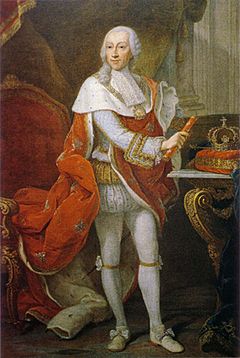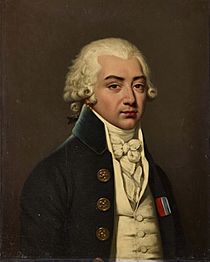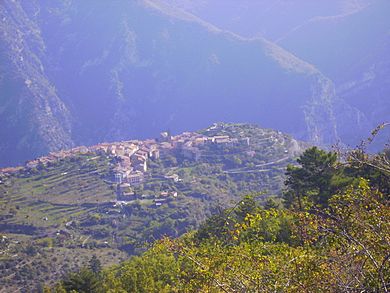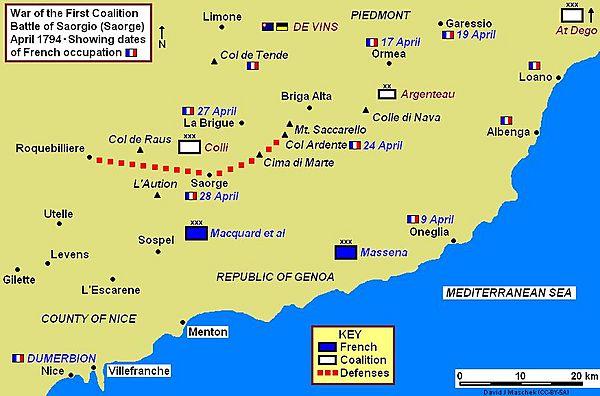Second Battle of Saorgio (1794) facts for kids
Quick facts for kids Battle of Saorgio |
|||||||
|---|---|---|---|---|---|---|---|
| Part of the War of the First Coalition | |||||||
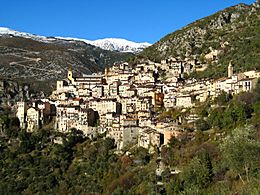 Saorge looking north toward the Col de Tende |
|||||||
|
|||||||
| Belligerents | |||||||
| Commanders and leaders | |||||||
| Strength | |||||||
| 20,000 | 8,000 | ||||||
| Casualties and losses | |||||||
| 1,500 | 3,000 | ||||||
The Second Battle of Saorgio was a fight that happened from April 24 to 28, 1794. It was part of the War of the First Coalition, a big conflict during the French Revolutionary Wars. The battle took place near the town of Saorge, which was then called Saorgio and belonged to Piedmont (part of the Kingdom of Sardinia).
The battle was a big win for the French army. They were led by General Pierre Jadart Dumerbion, with key parts of the battle managed by André Masséna. A young artillery general named Napoleon Bonaparte actually helped plan the whole attack. The French fought against the armies of the Kingdom of Sardinia and the Austrian Empire, who were led by Michelangelo Alessandro Colli-Marchi. This victory helped the French take control of important areas in the mountains and along the Mediterranean coast.
Contents
Background to the Conflict
The Kingdom of Sardinia faced a tough situation when war broke out with France in 1792. Two of its regions, the County of Nice and the Duchy of Savoy, were located on the French side of the Alps. This made them hard to defend. King Victor Amadeus III of Sardinia tried to get help from Austria while also talking to the French about peace.
Early French Attacks
War began in spring 1792. On September 21, French General Anne-Pierre, marquis de Montesquiou-Fézensac invaded Savoy, and the local defenses quickly fell apart. The French took the city of Chambéry on September 24. Three days later, another French force captured Nice without a fight, then took Villefranche-sur-Mer. Savoy later became part of France.
On September 23, 1792, French ships landed troops at the Piedmontese port of Oneglia. These soldiers looted the town before leaving. Later, on November 18, Sardinian forces successfully pushed back the French at Sospel. The French then moved back to L'Escarène for the winter.
Allied Leadership and Early Battles
King Victor Amadeus III of Sardinia was unhappy with his generals. He asked the Austrians to send a commander to lead both the Austrian and Sardinian armies. Joseph Nikolaus De Vins, an Austrian general, was chosen for this role in December 1792. However, Austria didn't fully trust Sardinia, as France was trying to make peace with them. The execution of King Louis XVI of France in January 1793 made other European rulers even more against France.
In February 1793, French troops led by Duke of Biron fought Sardinian soldiers at Levens. The French won, but both sides had many casualties. The Sardinian army had a very strong defensive spot at Saorge, which blocked the way to the important Tenda Pass.
In June 1793, the French Army of Italy won a small victory near Saorge. However, in the First Battle of Saorgio on June 12, the French were defeated. This attack was poorly planned and ended badly for them.
Failed Counterattack
The Austrian and Sardinian allies tried to attack back, but their new commander, De Vins, was very slow. He suffered from gout and tried to manage the attacks from Turin, which was too far away. This made his plans difficult to follow. In September 1793, a French force pushed back a Sardinian column at the Battle of Epierre. The French lost 500 men, while the Sardinians lost 1,000.
Another Sardinian general, Count of Saint-André, was supposed to advance on Nice from Saorgio. But there were problems between him and his Austrian officer, Michelangelo Alessandro Colli-Marchi. Also, De Vins' chief of staff, Eugène-Guillaume Argenteau, didn't get along with most of the Sardinian officers.
At this time, parts of southern France rebelled against the government. This meant many French soldiers had to go fight in places like the Siege of Toulon. This gave Sardinia a chance to get back its lost land. The king and De Vins went to the front in August to oversee the southern attack. In October, Sardinian troops defeated the French at Gilette. A few days later, there was a small fight at Utelle. The allied attack ended when heavy snow fell in the mountains, forcing the king to stop the campaign and go back to Turin in November.
The Battle of Saorgio (1794)
At the start of 1794, the Sardinian and Austrian forces held a very strong defensive line. This line stretched from Roquebillière in the west, through several mountain peaks, to Saorge. From Saorge, it continued northeast to other peaks and passes. This line was so strong that the French decided to try to go around it from the east.
French Planning and Strategy
General Pierre Jadart Dumerbion was in charge of the French Army of Italy. He was an older general who had seen many commanders punished for failing. To stay safe, Dumerbion decided to listen to the powerful government representatives who were with the army. These representatives were influenced by a newly promoted general named Napoleon Bonaparte, who was the army's new artillery chief.
Bonaparte created a smart plan. He suggested a main attack along the coast to capture Oneglia. This port was a base for Sardinian ships that attacked French grain supplies. From Oneglia, the French would turn north to take Ormea, which would get them behind the enemy's defenses from the east. While these moves happened, the main French army would attack Saorge directly to keep the enemy busy. Out of Dumerbion's 43,000 soldiers, 20,000 were part of this attack.
French Advance and Flanking Move
The French attack began on April 6, 1794. They moved through neutral land belonging to the Republic of Genoa and captured the port of Oneglia on April 9. The Sardinian general in that area, Argenteau, tried to defend Ormea. But the French advance, led by General André Masséna, easily pushed his men aside. The French captured Ormea around April 17 and Garessio on April 19.
Colli, the new commander at Saorge, now found his position surrounded from the side. De Vins told Colli to hold his ground but to send away any troops he didn't immediately need. There was so much tension between the Austrian and Sardinian allies that some Sardinian officers even thought De Vins might betray them.
Key Clashes
On April 24, the main French army attacked Saorge from the front. Colli's defenders included several Austrian and Sardinian battalions. On the same day, General Masséna successfully attacked the Col Argente with his division. Three days later, on April 27, the French captured La Brigue, causing heavy losses for the Sardinians.
Outcome of the Battle
The French took control of Saorgio on April 28 after Colli pulled his troops back. He left the Tenda Pass and retreated north to Limone Piemonte. In early May, Colli moved even further back to Borgo San Dalmazzo, near the fortress of Cuneo. Along the coast, the French continued their advance, taking Albenga and Loano.
General François Macquard occupied the Tenda Pass. Further east, Masséna placed his troops to hold the high ground between Ormea and Loano. In the fighting near Saorge, the French lost about 1,500 soldiers killed or wounded. The allied forces lost around 2,800.
After this victory, Napoleon and the government representatives suggested a new plan to keep pushing forward. However, this plan was stopped by Lazare Carnot, a powerful French leader. The defeat was a big shock for the Austrians and Sardinians. It led them to sign a new agreement on May 29. In this agreement, the Sardinians promised to defend the mountain passes, while the Austrians agreed to protect the coast. The next major battle in this area was the First Battle of Dego in September 1794.
Images for kids


